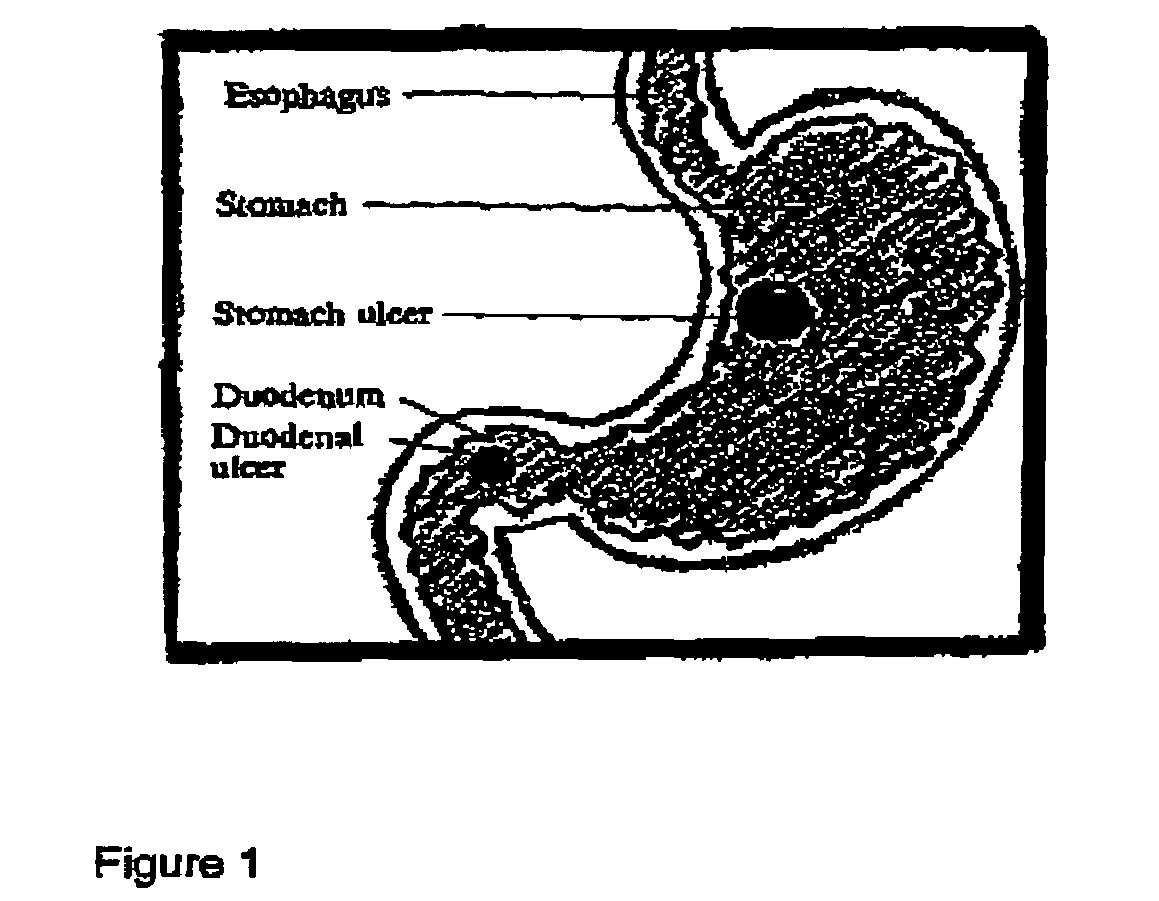Methods for treating ulcers and gastroesophageal reflux disease
a gastroesophageal reflux disease and ulcer technology, applied in the field of ulcers and/or gastroesophageal reflux disease, can solve the problems of ulcer formation, ulcer formation, inflammation and ulcers, and the inability of the stomach to defend itsel
- Summary
- Abstract
- Description
- Claims
- Application Information
AI Technical Summary
Benefits of technology
Problems solved by technology
Method used
Image
Examples
example 1
Method for Making a Botulinum Toxin Tablet for Oral Ingestion
[0144]A botulinum toxin can be compounded as an oral formulation for release of the toxin active ingredient in the stomach or duodenum. This is easily accomplished by mixing with a mortar and pestle (at room temperature without addition of any water or saline) 50 units of a commercially available lyophilized botulinum toxin powder, such as non-reconstituted BOTOX® (or 200 units of DYSPORT® powder) with a biodegradable carrier such as flour or sugar. Alternately, the botulinum toxin can be mixed by homogenization or sonication to form a fine dispersion of the powdered toxin in the carrier. The mixture can then compressed with a tablet making machine (such as the tablet press available from Scheu & Kniss, 1500 W. Ormsby Ave, Louisville, Ky. 40210) to make an ingestible tablet. Alternately, the toxin can be formulated with gelatin by well known methodologies to make an ingestible geltab.
example 2
Method for Treating a Peptic Ulcer
[0145]A 52 year old male presents with a burning pain in the abdomen between the breastbone and the navel and he relates that the pain often occurs between meals and in the early hours of the morning. The patient also complains of nausea and loss of appetite. Endoscopy, supplemented by barium x-ray, confirms the presence of a gastric ulcer. The ulcer proves intractable to H2-blockers as well as to antibiotics to H. pylori. The patient is treated by administration of the botulinum toxin oral formulation of Example 1. Thus, the patient swallows one 50 units type A tablet during each of four days. Within two weeks the symptoms of a peptic ulcer have disappeared and endoscopy reveals no trace of the ulcer.
example 3
Method for Treating Gastroesophageal Reflux Disease
[0146]A 62 year old obese female is admitted with symptoms of heartburn, near continuous belching, regurgitation, sore throat, difficulty swallowing and cough. Work up indicates esophagitis and esophageal manometry points to low (lower esophageal sphincter (LES) pressure. The Bernstein test for gastric acid reflux is positive. Thus, a diagnosis of GERD is made. The patient has been unsuccessful in various weight loss programs and regularly ingests chocolates, and smokes heavily. Antacids and histamine H2 receptor blockers have been ineffective. The patient is treated by administration of the botulinum toxin oral formulation of Example 1. Thus, the patient swallows one 2000 unit type B tablet during each of four days. Within two weeks the symptoms of GERD have disappeared or been substantially reduced.
[0147]Compositions and methods according to the invention disclosed herein has many advantages, including the following:
[0148]1. a bot...
PUM
| Property | Measurement | Unit |
|---|---|---|
| pH | aaaaa | aaaaa |
| stress | aaaaa | aaaaa |
| shape | aaaaa | aaaaa |
Abstract
Description
Claims
Application Information
 Login to View More
Login to View More - R&D
- Intellectual Property
- Life Sciences
- Materials
- Tech Scout
- Unparalleled Data Quality
- Higher Quality Content
- 60% Fewer Hallucinations
Browse by: Latest US Patents, China's latest patents, Technical Efficacy Thesaurus, Application Domain, Technology Topic, Popular Technical Reports.
© 2025 PatSnap. All rights reserved.Legal|Privacy policy|Modern Slavery Act Transparency Statement|Sitemap|About US| Contact US: help@patsnap.com

